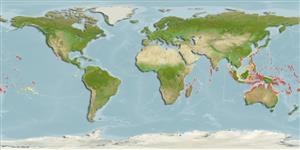Teleostei (teleosts) >
Ovalentaria/misc (Various families in series Ovalentaria) >
Pomacentridae (Damselfishes) > Microspathodontinae
Etymology: Stegastes: Greek, stegastos, -e, -on = covered (Ref. 45335).
More on authors: Schlegel & Müller.
Environment: milieu / climate zone / depth range / distribution range
Ecology
Marine; reef-associated; non-migratory; depth range 0 - 4 m (Ref. 1602). Tropical; 35°N - 35°S
Indo-Pacific: Seychelles and Reunion to the Line and Tuamoto islands, north to the Ryukyu Islands, south to New Caledonia.
Size / Weight / Age
Maturity: Lm ? range ? - ? cm
Max length : 13.0 cm TL male/unsexed; (Ref. 9710)
Dorsal
spines
(total): 12;
Dorsal
soft rays
(total): 15-16;
Anal
spines: 2;
Anal
soft rays: 12 - 14. Diagnosis: Body dark brown to blackish; suborbital mostly blue with blue spots on side of head; most scales on side of body with blue transverse streak. Fins dark brown to blackish except pectorals which are translucent with dusky rays. Pectorals with scaly inner base and has pupil-sized black spot at the base of uppermost rays; a black spot (maybe bordered anteriorly with white) at base of posterior dorsal rays, slightly extending onto dorsal edge of caudal peduncle; with or without white bar across posterior half of body (Ref. 510). Body depth 1.8-2.1 in SL (Ref. 90102).
A territorial herbivore. Adults inhabit reef flats, shallow lagoons, and semi-sheltered reef margins; common among patches of rubble or porous reef rock, surrounded by live coral, particularly in areas of mild surge (Ref. 1602). Also in high energy zones with mixed corals and short algae. They occur in small loose aggregations (Ref. 48636). Feeds on filamentous algae (Ref. 89972). Oviparous, distinct pairing during breeding (Ref. 205). Eggs are demersal and adhere to the substrate (Ref. 205). Males guard and aerate the eggs (Ref. 205).
Life cycle and mating behavior
Maturity | Reproduction | Spawning | Eggs | Fecundity | Larvae
Oviparous, distinct pairing during breeding (Ref. 205). Eggs are demersal and adhere to the substrate (Ref. 205). Males guard and aerate the eggs (Ref. 205).
Allen, G.R. and A.R. Emery, 1985. A review of the Pomacentrid fishes of the genus Stegastes from the Indo-Pacific, with descriptions of two new species. Indo-Pac. Fish. (3):31. (Ref. 510)
IUCN Red List Status (Ref. 130435)
Threat to humans
Harmless
Human uses
More information
ReferencesAquacultureAquaculture profileStrainsGeneticsElectrophoresesHeritabilityDiseasesProcessingNutrientsMass conversion
Tools
Special reports
Download XML
Internet sources
Estimates based on models
Preferred temperature (Ref.
123201): 25.1 - 29.3, mean 28.3 °C (based on 2041 cells).
Phylogenetic diversity index (Ref.
82804): PD
50 = 0.5000 [Uniqueness, from 0.5 = low to 2.0 = high].
Bayesian length-weight: a=0.01950 (0.01004 - 0.03785), b=2.99 (2.82 - 3.16), in cm total length, based on LWR estimates for this species & Genus-body shape (Ref.
93245).
Trophic level (Ref.
69278): 2.0 ±0.00 se; based on food items.
Resilience (Ref.
120179): High, minimum population doubling time less than 15 months (Preliminary K or Fecundity.).
Fishing Vulnerability (Ref.
59153): Low vulnerability (10 of 100).
Nutrients (Ref.
124155): Calcium = 117 [58, 198] mg/100g; Iron = 0.78 [0.46, 1.38] mg/100g; Protein = 18.1 [16.8, 19.3] %; Omega3 = 0.0839 [, ] g/100g; Selenium = 17.3 [8.9, 37.0] μg/100g; VitaminA = 76.1 [17.7, 308.1] μg/100g; Zinc = 2.06 [1.33, 3.18] mg/100g (wet weight);
